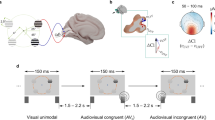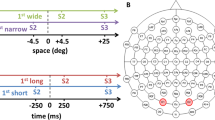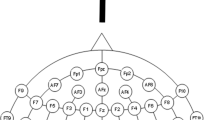Abstract
It has been shown that stimuli of a task-irrelevant modality receive enhanced processing when they are presented at an attended location in space (crossmodal attention). The present study investigated the effects of visual deprivation on the interaction of the intact sensory systems. Random streams of tactile and auditory stimuli were presented at the left or right index finger of congenitally blind participants. They had to attend to one modality (auditory or tactile) of one side (left or right) and had to respond to deviant stimuli of the attended modality and side. While in a group of sighted participants, early event-related potentials (ERPs) were negatively displaced to stimuli presented at the attended position, compared to the unattended, for both the task-relevant and the task-irrelevant modality, starting as early as 80 ms after stimulus onset (unimodal and crossmodal spatial attention effects, respectively), corresponding crossmodal effects could not be detected in the blind. In the sighted, spatial attention effects after 200 ms were only significant for the task-relevant modality, whereas a crossmodal effect for this late time window was observed in the blind. This positive rather than negative effect possibly indicates an active suppression of task-irrelevant stimuli at an attended location in space. The present data suggest that developmental visual input is essential for the use of space to integrate input of the non-visual modalities, possibly because of its high spatial resolution. Alternatively, enhanced perceptual skills of the blind within the intact modalities may result in reduced multisensory interactions (“inverse effectiveness of multisensory integration”).







Similar content being viewed by others
Notes
The earliest point in time when deviant stimuli physically differed from standard stimuli was 95 ms for tactile stimuli and 90 ms for auditory stimuli. When averaged time logged to gap onset, this time epoch would roughly correspond to that used in earlier studies (e.g, Kujala et al. 1995, Röder et al. 1996).
Variance of peak latencies at central cluster C5 for the N100: sblind=6.04, ssighted=10.25, P<0.05; for the P200: sblind=11.75, ssighted=20.4, P<0.05)
References
Alho K, Kujala T, Paavilainen P, Summala H, Näätänen R (1993) Auditory processing in visual brain areas of the early blind: evidence from event-related potentials. Electroencephalogr Clin Neurophysiol 86:418–427
Alho K, Woods DL, Algazi A (1994) Processing of auditory stimuli during auditory and visual attention as revealed by event-related potentials. Psychophysiology 31:469–479
Calvert G, Spence C, Stein BE (2004) Handbook of multisensory processes. MIT Press, Cambridge
Chelazzi L, Miller EK, Duncan J, Desimone R (1993) A neural basis for visual search in inferior temporal cortex. Nature 363:345–347
Drevets WC, Burton H, Videen TO, Snyder AZ, Simpson JR, Raichle ME (1995) Blood flow changes in human somatosensory cortex during anticipated stimulation. Nature 373:249–252
Driver J (2001) A selective review of selective attention research from the past century. Br J Psychol 92:53–78
Driver J, Spence C (1998) Attention and the crossmodal construction of space. Trends Cogn Sci 2:254–262
Driver J, Spence C (2000) Multisensory perception: beyond modularity and convergence. Curr Biol 10:R731–R735
Eimer M, Driver J (2000) An event-related brain potential study of cross-modal links in spatial attention between vision and touch. Psychophysiology 37:697–705
Eimer M, Driver J (2001) Crossmodal links in endogenous and exogenous spatial attention: evidence from event-related brain potential studies. Neurosci Biobehav Rev 25:497–511
Eimer M, Schröger E (1998) ERP effects of intermodal attention and cross-modal links in spatial attention. Psychophysiology 35:313–327
Eimer M, Van Velzen J (2002) Crossmodal links in spatial attention are mediated by supramodal control processes: evidence from event-related potentials. Psychophysiology 39:437–449
Eimer M, Cockburn D, Smedley B, Driver J (2001) Cross-modal links in endogenous spatial attention are mediated by common external locations: evidence from event-related brain potentials. Exp Brain Res 139:398–411
Eimer M, van Velzen J, Driver J (2002) Cross-modal interactions between audition, touch, and vision in endogenous spatial attention: ERP evidence on preparatory states and sensory modulations. J Cogn Neurosci 14:254–271
Ernst MO, Banks MS (2002) Humans integrate visual and haptic information in a statistically optimal fashion. Nature 415:429–433
García-Larrea L, Lukaszewicz A-L, Mauguière F (1995) Somatosensory responses during selective spatial attention: the N120-to-N140 transition. Psychophysiology 32:526–537
Halgren E, Baudena P, Clarke JM, Heit G, Liégeois C, Chauvel P, Musolino A (1995) Intracerebral potentials to rare target and distractor auditory and visual stimuli. Superior temporal plane and parietal lobe. Electroencephalogr Clin Neurophysiol 94:191–220
Hansen JC, Hillyard SA (1983) Selective attention to multimdimensional auditory stimuli. J Exp Psychol Hum Percept Perform 9:1–19
Hillyard SA, Hink RF, Schwent VL, Picton TW (1973) Electrical signs of selective attention in the human brain. Science 182:177–180
Hillyard SA, Simpson GV, Woods DL, VanVoorhis S, Münte TF (1984) Event-related brain potentials and selective attention to different modalities. In: Reinoso-Suárez F, Ajmone-Marsan C (eds) Cortical integration. Raven Press, New York, pp 395–414
Hötting K, Röder B (2004) Hearing cheats touch, but less in congenitally blind than in sighted individuals. Psychol Sci 15:60–64
Hötting K, Rösler F, Röder B (2003) Crossmodal and intermodal attention modulate event-related brain potentials to tactile and auditory stimuli. Exp Brain Res 148:26–37
Johansen-Berg H, Lloyd DM (2000) The physiology and psychology of selective attention to touch. Front Biosci 5:d894–904
Kennett S, Eimer M, Spence C, Driver J (2001) Tactile-visual links in exogenous spatial attention under different postures: convergent evidence from psychophysics and ERPs. J Cogn Neurosci 13:462–478
Knight RT (1990) Neural mechanisms of event-related potentials: evidence from human lesion studies. In: Rohrbauch JW, Parasuraman R, Johnson RJ (eds) Event-related brain potentials: basic issues and applications. Oxford University Press, New York, pp 3–18
Knudsen EI, Esterly SD, du Lac S (1991) Stretched and upside-down maps of auditory space in the optic tectum of blind-reared owls: Acoustic basis and behavioral correlates. J Neurosci 11:1727–1747
Kujala T, Alho K, Paavilainen P, Summala H, Näätänen R (1992) Neural plasticity in processing of sound location by the early blind: an event-related potential study. Electroencephalogr Clin Neurophysiol 84:469–472
Kujala T, Alho K, Kekoni J, Hämäläinen H, Reinikainen K, Salonen O, Standertskjöld-Nordenstam C-G, Näätänen R (1995) Auditory and somatosensory event-related brain potentials in early blind humans. Exp Brain Res 104:519–526
Kujala T, Alho K, Huotilainen M, Ilmoniemi RJ, Lehtokoski A, Leinonen A, Rinne T, Salonen O, Sinkkonen J, Standertskjöld-Nordenstam C-G, Näätänen R (1997) Electrophysiological evidence for cross-modal plasticity in humans with early- and late-onset blindness. Psychophysiology 34:213–216
Lewkowicz DJ (2002) Heterogeneity and heterochrony in the development of intersensory perception. Cogn Brain Res 14:41–63
Lewkowicz DJ, Turkewitz G (1980) Cross-modal equivalence in early infancy: auditory-visual intensity matching. Dev Psychol 16:597–607
Liotti M, Ryder K, Woldorff MG (1998) Auditory attention in the congenitally blind: where, when and what gets reorganized? Neuroreport 9:1007–1012
Lloyd DM, Merat N, McGlone F, Spence C (2003) Crossmodal links between audition and touch in covert endogenous spatial attention. Percept Psychophys 65:901–924
Macaluso E, Frith CD, Driver J (2000) Modulation of human visual cortex by crossmodal spatial attention. Science 289:1206–1208
McCarthy G, Wood CC (1985) Scalp distributions of event-related potentials: an ambiguity associated with analysis of variance models. Electroencephalogr Clin Neurophysiol 62:203–208
McDonald JJ, Ward LM (2000) Involuntary listening aids seeing: evidence from human electrophysiology. Psychol Sci 11:167–171
McDonald JJ, Teder-Sälejärvi WA, Di Russo F, Hillyard SA (2003) Neural substrates of perceptual enhancement by cross-modal spatial attention. J Cogn Neurosci 15:10–19
Meltzoff AN, Borton RW (1979) Intermodal matching by human neonates. Nature 282:403–404
Michie PT (1984) Selective attention effects on somatosensory event-related potentials. Ann N Y Acad Sci 425:250–255
Näätänen R (1982) Processing negativity: an evoked-potential reflection of selective attention. Psychol Bull 92:605–640
Näätänen R (1992) Attention and brain function. Lawrence Erlbaum Associates, Hillsdale, NJ
Näätänen R, Gaillard AWK, Varey CA (1981) Attention effects on auditory ERPs as a function of inter-stimulus interval. Biol Psychol 13:173–187
Piaget J (1952) The origin of intelligence in children. International University Press, New York
Posner MI (1980) Orienting of attention. Q J Exp Psychol 32:3–25
Rauschecker JP, Korte M (1993) Auditory compensation for early blindness in cat cerebral cortex. J Neurosci 13:4538–4548
Röder B, Neville HJ (2003) Developmental functional plasticity. In: Grafman J, Robertson I (eds) Plasticity and rehabilitation. Handbook of Neuropsychology, vol 9. Elsevier, Amsterdam, pp 231–270
Röder B, Rösler F, Hennighausen E, Näcker F (1996) Event-related potentials during auditory and somatosensory discrimination in sighted and blind human subjects. Cogn Brain Res 4:77–93
Röder B, Rösler F, Neville H (1999) Effects of interstimulus interval on auditory event-related potentials in congenitally blind and normally sighted humans. Neurosci Lett 264:53–56
Schicke T, Demuth L, Röder B (2002) Influence of visual information on the auditory median plane of the head. Neuroreport 13:1627–1629
Spence C (2002) Multisensory attention and tactile information-processing. Behav Brain Res 135:57–64
Stein BE, Meredith MA (1993) The merging of the senses. MIT Press, Cambridge
Teder-Sälejärvi WA, Münte TF, Sperlich F-J, Hillyard SA (1999) Intra-modal and cross-modal spatial attention to auditory and visual stimuli. An event-related brain potential study. Cogn Brain Res 8:327–343
Turkewitz G, Kenny PA (1982) Limitations on input as a basis for neural organization and perceptual development: a preliminary theoretical statement. Dev Psychobiol 15:357–368
Van Velzen J, Forster B, Eimer M (2002) Temporal dynamics of lateralized ERP components elicited during endogenous attentional shifts to relevant tactile events. Psychophysiology 39:874–878
Wallace MT, Stein BE (1997) Development of multisensory neurons and multisensory integration in cat superior colliculus. J Neurosci 17:2429–2444
Wallace MT, Stein BE (2001) Sensory and multisensory responses in the newborn monkey superior colliculus. J Neurosci 21:8886–8894
Wallace MT, Wilkinson LK, Stein BE (1996) Representation and integration of multiple sensory inputs in primate superior colliculus. J Neurophysiol 76:1246–1266
Wallace MT, Meredith MA, Stein BE (1998) Multisensory integration in the superior colliculus of the alert cat. J Neurophysiol 80:1006–1010
Wallace MT, Hairston WD, Stein BE (2001) Long-term effects of dark-rearing on multisensory processing (abstract 27). Soc Neurosci Program no 511.6
Warren DH, Pick HL (1970) Intermodality reliations in localization in blind and sighted people. Percept Psychophys 8:430–432
Withington-Wray DJ, Binns KE, Keating MJ (1990) The maturation of the superior colliculus map of auditory space in the guinea pig is disrupted by developmental visual deprivation. Eur J Neurosci 2:682–692
Woods DL (1990) The physiological basis of selective attention: implications of event-related potential studies. In: Rohrbaugh JW, Parasurama R, Johnson J (eds) Event-related brain potentials: basic issues and applications. Oxford University Press, New York, pp 178–209
Woods DL, Alho K, Algazi A (1992) Intermodal selective attention. I. Effects on event-related potentials to lateralized auditory and visual stimuli. Electroencephalogr Clin Neurophysiol 82:541–555
Acknowledgements
The study was supported by a grant from the German Research Foundation (DFG) Ro 1226/4-1, 4-2, 4-3 to B.R. The Study Center for the Blind (Deutsche Blindenstudienanstalt) and the German Society for Blind and Visually Handicapped in Study and Occupation (DVBS) helped to recruit blind participants. We thank Dipl. Psych. Matthias Gondan for programming support and Anne Flämig and Wolfgang Pauli for their help during data acquisition.
Author information
Authors and Affiliations
Corresponding author
Rights and permissions
About this article
Cite this article
Hötting, K., Rösler, F. & Röder, B. Altered auditory-tactile interactions in congenitally blind humans: an event-related potential study. Exp Brain Res 159, 370–381 (2004). https://doi.org/10.1007/s00221-004-1965-3
Received:
Accepted:
Published:
Issue Date:
DOI: https://doi.org/10.1007/s00221-004-1965-3




